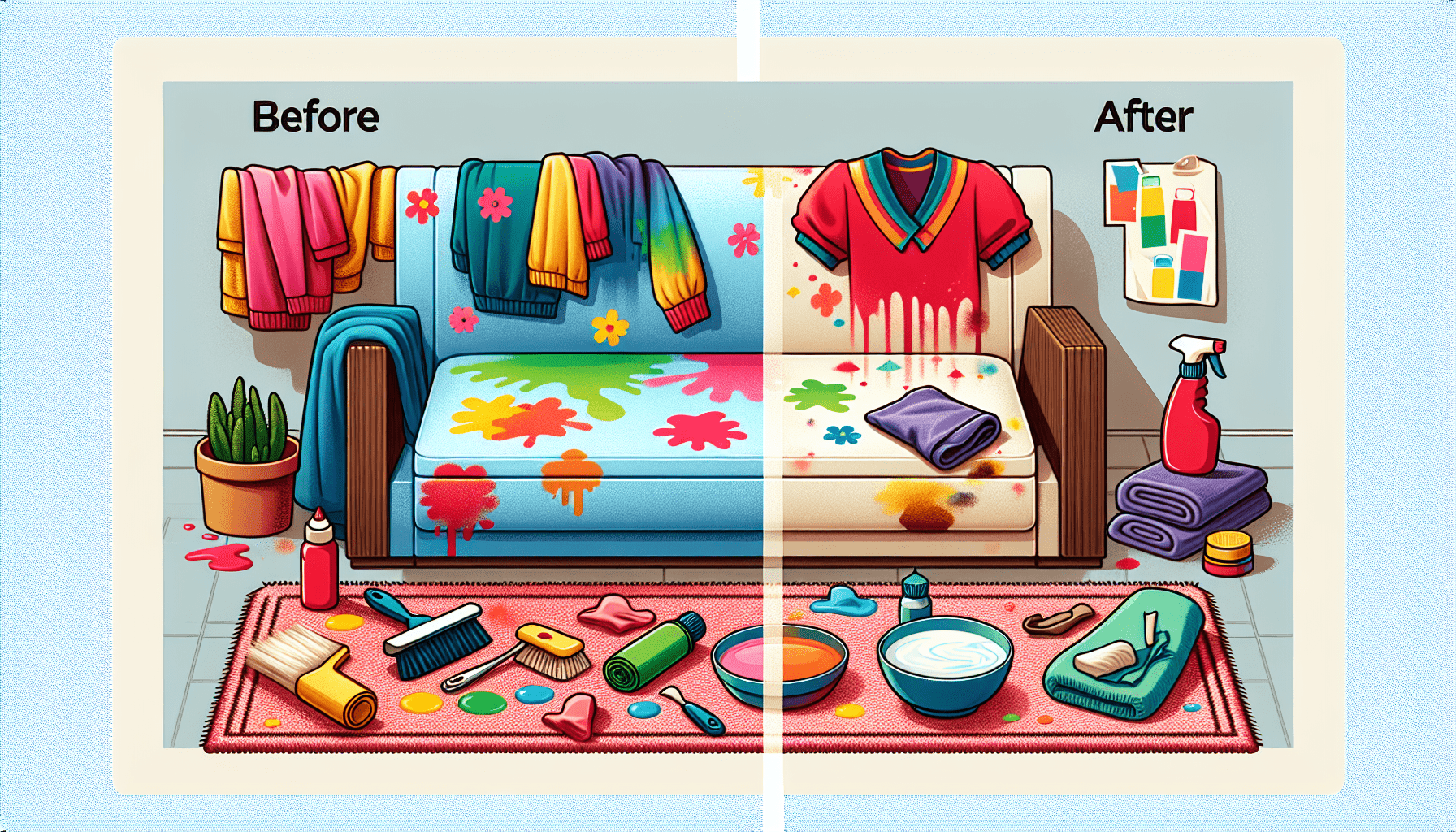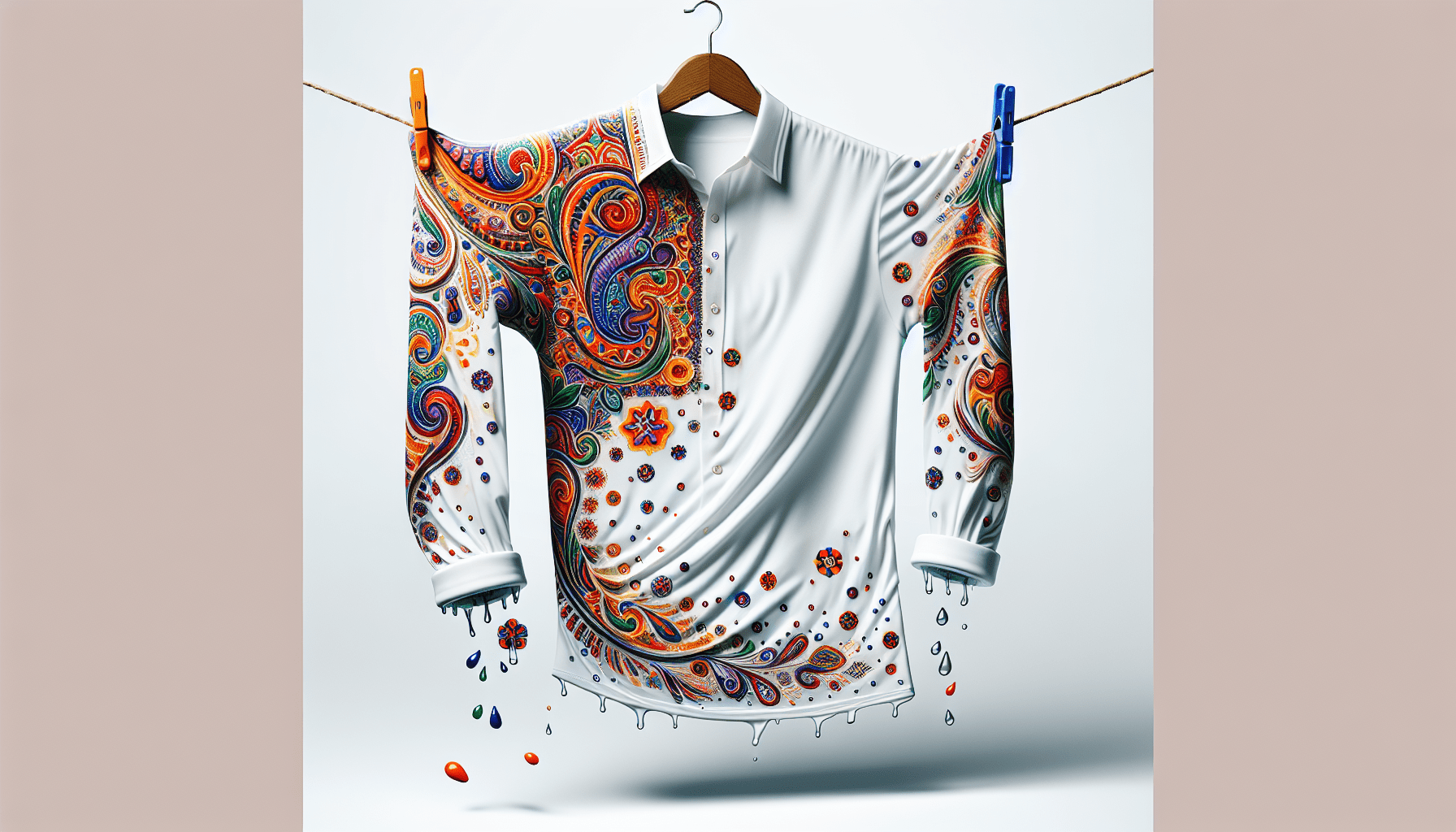In this article, you will learn the essential steps in setting fabric paint to ensure long-lasting and vibrant results. By following these guidelines, you will gain valuable knowledge on how to effectively set fabric paint, allowing you to achieve professional-looking designs on various textiles. From prepping your fabric to selecting the appropriate setting method, this article will equip you with the necessary information to make your fabric paint creations last. Whether you are a seasoned artist or new to fabric painting, mastering the art of setting fabric paint is crucial to achieving durable and beautifully preserved creations.

What is fabric paint?
Fabric paint is a type of paint specifically designed for use on fabrics. It allows you to create unique designs and patterns on clothing, accessories, and home decor items. Unlike regular paint, fabric paint is formulated to adhere to fabric fibers and withstand washing and wear. It comes in various colors and finishes, providing endless possibilities for customization.
Definition of fabric paint
Fabric paint is a specialized type of paint that is designed to adhere to fabric fibers. It contains pigments and binders that allow it to bond with the fabric and prevent it from fading or washing out. Fabric paint is typically available in liquid form and can be applied using brushes, stencils, or stamps. It is a versatile medium that allows for the creation of custom designs and decorations on fabric surfaces.
Different types of fabric paint
There are several types of fabric paint available, each with its own unique properties and applications. The three most common types of fabric paint are water-based fabric paint, acrylic fabric paint, and fabric spray paint.
Water-based fabric paint is a popular choice for beginners and crafters because it is easy to use and clean up. It is typically available in liquid form and can be applied directly to the fabric using a brush or sponge. Water-based fabric paint is known for its vibrant colors and soft finish.
Acrylic fabric paint is a more durable option that provides a bolder and more opaque coverage. It is available in liquid or tube form and can be applied using brushes, stencils, or stamps. Acrylic fabric paint is known for its ability to withstand multiple washes without fading or cracking.
Fabric spray paint is a convenient option for large-scale or intricate designs. It comes in spray cans and can be applied directly onto the fabric, allowing for quick and easy coverage. Fabric spray paint offers a wide range of colors and finishes, including metallic and glitter options.
Preparing the fabric
Before applying fabric paint, it is important to properly prepare the fabric to ensure the best results and longevity of the design. This involves choosing the right fabric, washing it, and ironing it to remove any wrinkles or creases.
Choosing the right fabric
Not all fabrics are suitable for fabric painting. It is important to choose a fabric that is specifically labeled as suitable for painting or one that has a high synthetic fiber content. Natural fibers like cotton, linen, and silk tend to absorb the paint better and provide a smoother surface for application. Avoid using fabrics with a high percentage of synthetic materials as they may not absorb the paint properly.
Washing the fabric
Before painting, it is essential to wash the fabric to remove any dirt, oils, or sizing agents that may interfere with the adhesion of the paint. Use a gentle detergent and wash the fabric according to the care instructions provided. Avoid using fabric softeners or bleach, as they can affect the paint’s performance.
Ironing the fabric
After washing, iron the fabric to remove any wrinkles or creases. This will ensure a smooth and even surface for painting. Set the iron to the appropriate temperature for the fabric type and use a pressing cloth to protect the paint if it has already been applied. Iron the fabric in a back-and-forth motion, avoiding excessive pressure to prevent smudging or damaging the paint.
Choosing the right fabric paint
Choosing the right fabric paint is crucial for achieving the desired results and ensuring the longevity of the design. Consider the type of fabric you are working with, the desired finish, and the application method you prefer.
Water-based fabric paint
Water-based fabric paint is a versatile option suitable for a wide range of projects. It is easy to work with, dries quickly, and offers vibrant colors and a soft finish. It is ideal for beginners and crafters who want to experiment with fabric painting. Water-based fabric paint is typically available in bottles or jars, and it can be applied using brushes, sponges, or even your fingers.
Acrylic fabric paint
Acrylic fabric paint is a more durable option that provides a bolder and more opaque coverage. It is suitable for both light and dark fabrics and offers a wide range of colors. Acrylic fabric paint typically comes in liquid or tube form and can be applied using brushes, stencils, or stamps. It is known for its ability to withstand multiple washes without fading or cracking.
Fabric spray paint
Fabric spray paint is a convenient option for larger projects or intricate designs. It comes in spray cans and can be applied directly onto the fabric, allowing for quick and easy coverage. Fabric spray paint offers a wide range of colors and finishes, including metallic and glitter options. It is perfect for adding intricate details, stenciling, or achieving gradient effects.
Gathering the necessary materials
Before starting your fabric painting project, it is important to gather all the necessary materials to ensure a smooth and efficient process.
Fabric paint
Choose the fabric paint that best suits your project and preferences. Consider the type, color, and finish you desire. Determine how much fabric paint you will need based on the size of your project and the desired level of coverage.
Paint brushes
Select a variety of paint brushes in different sizes and shapes to accommodate different painting techniques and designs. For detailed work, choose brushes with fine tips. Larger brushes can be used for broader strokes or covering larger areas.
Stencil or stamps (if desired)
If you wish to use stencils or stamps to create patterns or designs, make sure to have them on hand. Stencils can be purchased or created at home using cardboard or acetate sheets. Stamps can be purchased or made by carving designs onto rubber blocks.

Setting up your work area
Creating a suitable work area is essential for a smooth and successful fabric painting experience. Follow these steps to set up your work area properly.
Covering the work surface
Protect your work surface by covering it with a plastic tablecloth, old sheets, or newspapers. This will prevent any paint spills or splatters from staining or damaging your work surface.
Laying out the fabric
Prepare your fabric by laying it flat on the covered work surface. Smooth out any wrinkles or creases, ensuring a smooth and even surface for painting.
Organizing the paint and tools
Arrange your fabric paint bottles, brushes, and any other tools you may be using in a well-organized manner. This will make it easier for you to access the materials and prevent any accidental spills or messes.
Applying fabric paint
Now that you have everything prepared, it’s time to start applying fabric paint to your chosen fabric. Follow these steps to achieve the desired design and coverage.
Choosing the painting technique
Consider the design or pattern you want to create and choose a painting technique that suits your vision. Some common techniques include freehand painting, using stencils, or stamping. If you are a beginner, it may be helpful to practice on a scrap piece of fabric before starting on your main project.
Using paint brushes
If you are using paint brushes, dip the brush into the desired color of fabric paint and apply it to the fabric in smooth, even strokes. Experiment with different brush sizes and techniques to achieve different effects. Allow each layer of paint to dry before applying another layer or changing colors.
Using stencils or stamps
If you are using stencils or stamps, secure them firmly onto the fabric using painter’s tape or adhesive spray. Apply the fabric paint onto the stencil or stamp using a brush or sponge, then press it onto the fabric in a gentle dabbing or rolling motion. Carefully lift the stencil or stamp off the fabric to reveal the design.
Drying the paint
After applying the fabric paint, it is important to allow it to dry thoroughly before proceeding to the next steps. The drying time will vary depending on the type of fabric paint used and the thickness of the paint layers.
Air drying
Air drying is the most common and easiest method of drying fabric paint. Simply leave the painted fabric in a well-ventilated area and allow it to dry naturally. Avoid touching or moving the fabric during the drying process to prevent smudging or distorting the design.
Using a heat gun
If you need to speed up the drying process, you can use a heat gun. Set the heat gun to a low or medium setting and hold it a few inches away from the painted fabric. Move the heat gun in a sweeping motion to evenly distribute the heat and prevent overheating.
Using an iron
Another option for drying fabric paint is to use an iron. Set the iron to the appropriate temperature for the fabric type, and place a pressing cloth over the painted area. Use the iron to gently press the fabric, applying heat for a short amount of time. This will help to set the paint and prevent it from smudging or washing out.
Heat setting fabric paint
After the paint has dried, it is important to heat set it to ensure its permanence and longevity. Heat setting involves applying heat to the painted fabric, which helps to bond the paint to the fabric fibers.
Heat setting with an iron
To heat set fabric paint with an iron, set the iron to the temperature recommended by the fabric paint manufacturer. Place a pressing cloth over the painted area and press the iron on the cloth for a specified amount of time. Follow the manufacturer’s instructions for the recommended heat setting time.
Heat setting in an oven
If you prefer to heat set fabric paint in an oven, preheat the oven to the temperature specified by the fabric paint manufacturer. Place the painted fabric on a baking sheet or foil-covered tray and place it in the oven. Bake the fabric according to the manufacturer’s instructions, usually for a specified amount of time. Make sure to monitor the fabric closely to prevent overheating or burning.
Curing and washing the fabric
Curing is the process of allowing the painted fabric to fully bond and adhere to the fabric fibers. It is essential for the longevity of the paint design. After heat setting, allow the fabric to cure for a specific period of time before washing or wearing.
Curing fabric paint
To cure fabric paint, let the painted fabric sit undisturbed for at least 24-48 hours. During this time, avoid touching or moving the fabric to prevent smudging or damaging the paint. Curing allows the paint to fully bond with the fabric, ensuring its vibrancy and durability.
Washing and caring for the painted fabric
Once the paint has fully cured, you can wash the fabric to remove any excess paint particles or residue. Follow the care instructions provided by the fabric paint manufacturer. In general, it is recommended to wash fabric painted items in cold water on a gentle cycle. Avoid using harsh detergents or bleach, as they may fade or damage the paint. Hang or lay flat to dry, and avoid using a dryer or ironing directly on the painted area.
Troubleshooting common issues
While fabric painting can be a fun and rewarding process, there are some common issues that may arise. Here are a few troubleshooting tips to help overcome these challenges.
Fading or cracking paint
If your fabric paint starts to fade or crack over time, it may be due to incorrect heat setting or not allowing the paint to cure properly. Make sure to follow the heat setting instructions provided by the fabric paint manufacturer. Additionally, ensure that the paint has fully cured before washing or wearing the painted fabric.
Uneven color distribution
Uneven color distribution can occur if the fabric paint is not applied evenly or if the fabric absorbs the paint unevenly. To prevent this, make sure to mix the fabric paint thoroughly before applying it to the fabric. Apply the paint in thin and even layers, allowing each layer to dry before applying additional coats.
Stains or marks
If you accidentally spill or smudge fabric paint on unwanted areas of the fabric, it is important to act quickly. Use a damp cloth or sponge to blot the area, removing as much paint as possible. If the paint has already dried, try using a fabric paint remover or rubbing alcohol to gently lift the stain. Test any removers or solvents on a small, inconspicuous area of the fabric before applying them to the stained area.
In conclusion, fabric paint is a versatile medium that allows for the creation of custom designs and patterns on various fabric surfaces. By properly preparing the fabric, choosing the right fabric paint, and following the necessary steps for application, drying, and heat setting, you can achieve vibrant and long-lasting results. With a little practice and attention to detail, fabric painting can be a rewarding and enjoyable craft.



